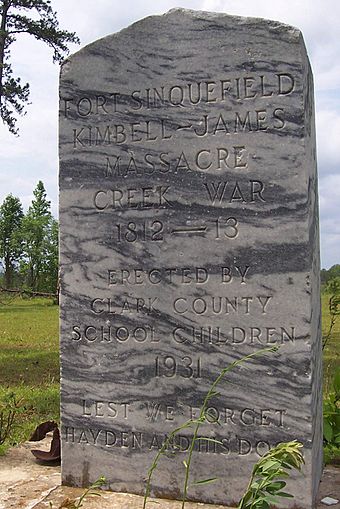Fort Sinquefield facts for kids
Quick facts for kids |
|
|
Fort Sinquefield
|
|
 |
|
| Location | Clarke County, Alabama, USA |
|---|---|
| Nearest city | Grove Hill, Alabama |
| Built | 1813 |
| NRHP reference No. | 74000403 |
| Added to NRHP | December 31, 1974 |
Fort Sinquefield was a wooden fort built a long time ago in Clarke County, Alabama. It was near the town of Grove Hill. Early settlers in Clarke County built this fort in 1813. They needed protection during a conflict called the Creek War. Warriors from the Creek nation attacked the fort in 1813.
A special marker was put up at the site in 1931 by children from Clarke County schools. The fort was added to the National Register of Historic Places on December 31, 1974. This means it is an important historical site.
Contents
History of Fort Sinquefield
When the Creek War happened, Clarke was a new county in the Mississippi Territory. The Creek War was a difficult time. It started as a disagreement among the Creek people themselves. Some Creek groups, called the Upper Towns, wanted to keep their old traditions. Other groups, the Lower Towns, had started to adopt more European-American ways. They disagreed about how to use their shared land and other important issues.
What Was the Creek War?
The first fights involving American settlers happened nearby. On July 27, 1813, white soldiers attacked a group of Creek warriors called the Red Sticks. This event is known as the Battle of Burnt Corn.
Attacks on Fort Mims and Fort Sinquefield
The next month, on August 30, 1813, the Red Sticks attacked Fort Mims. This fort was home to the Tensaw Creek, who were part of the Lower Towns. The Red Sticks believed the Tensaw had forgotten their traditional Creek values. Many people were gathered inside Fort Mims. These included Lower Town Creek, white settlers, and enslaved people. Most of them were killed in a sad event called the Fort Mims massacre.
After the attack on Fort Mims, many pioneer families and friendly Lower Creek people went to Fort Sinquefield for safety.
The Kimbell-James Attack
On September 1, 1813, Red Stick warriors attacked again. They were led by a leader named Josiah Francis. This time, they attacked the Ransom Kimbell and Abner James families. These families had left the crowded fort to go to Kimbell's cabin nearby. Most of the men managed to escape back to the fort. But twelve women were killed in what became known as the Kimbell-James Massacre. The next day, people from the fort went out to get the bodies for burial.
The Second Attack
The Red Sticks attacked Fort Sinquefield a second time that same day. They found several women washing clothes at a spring outside the fort. The warriors tried to stop the women from getting back to the fort. But the settlers inside the fort helped. They let out about 60 dogs, which scared the attackers. The Creek warriors killed one woman, Sarah Phillips. The other settlers made it safely back inside the fort. From there, they fired at the Red Sticks.
During this fight, several warriors were hurt. A settler named Stephen Lacey was also killed. The attack lasted for two hours before the Red Sticks left. Soon after, the people who survived at Fort Sinquefield moved. They went to a larger fort called Fort Madison, which was several miles south.
See also
 In Spanish: Fuerte Sinquefield para niños
In Spanish: Fuerte Sinquefield para niños



